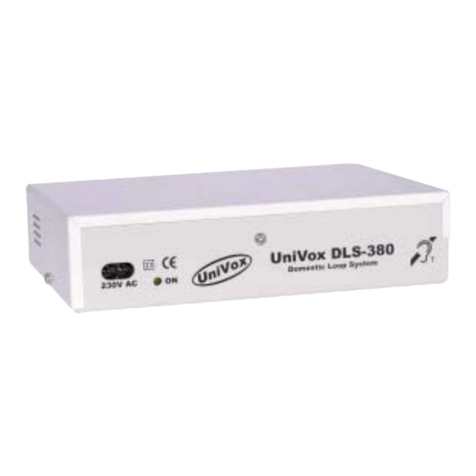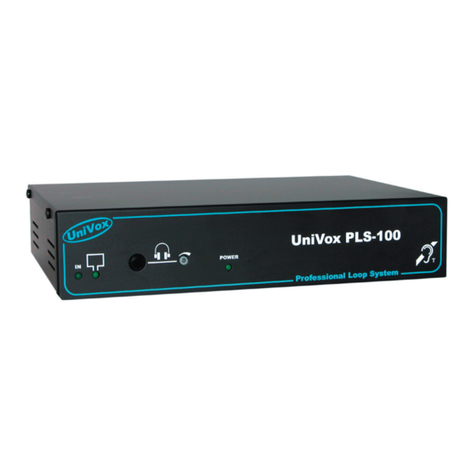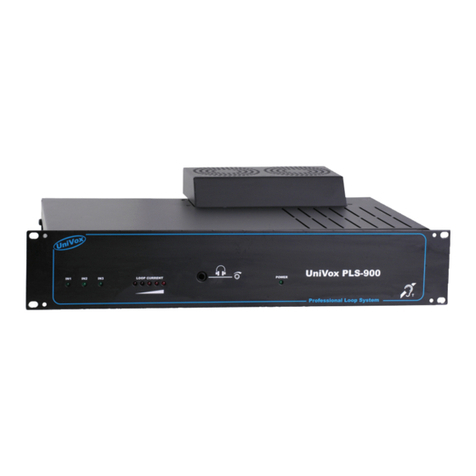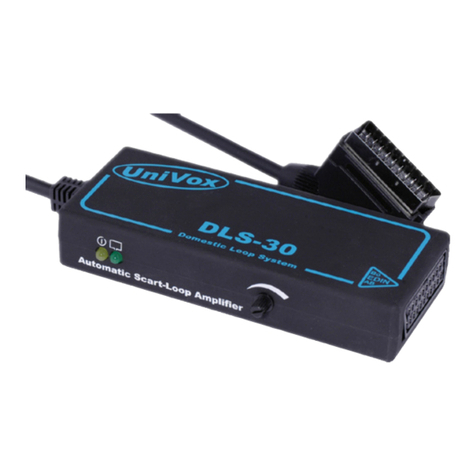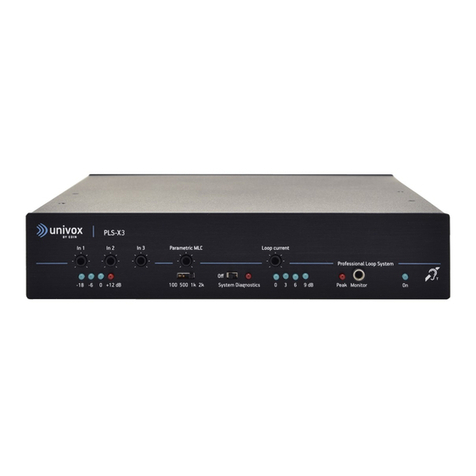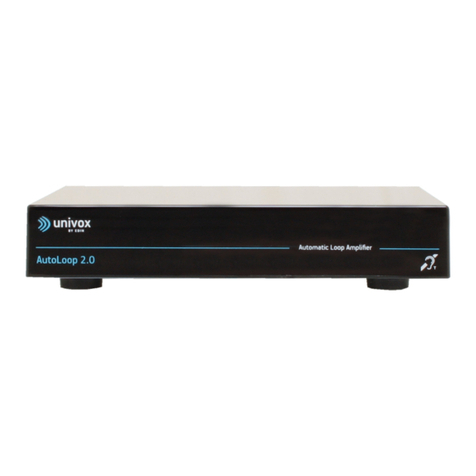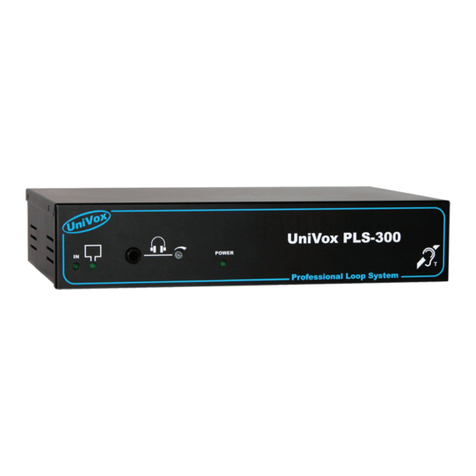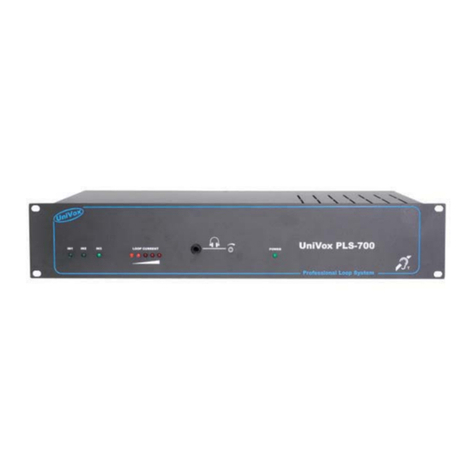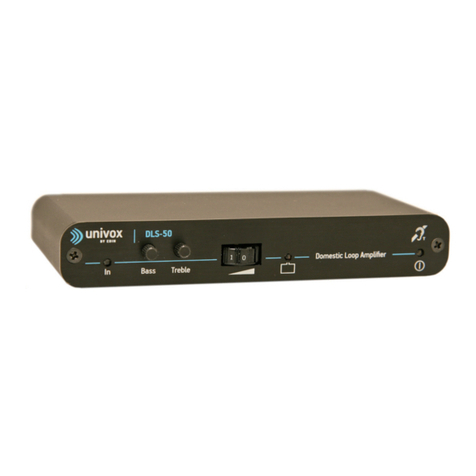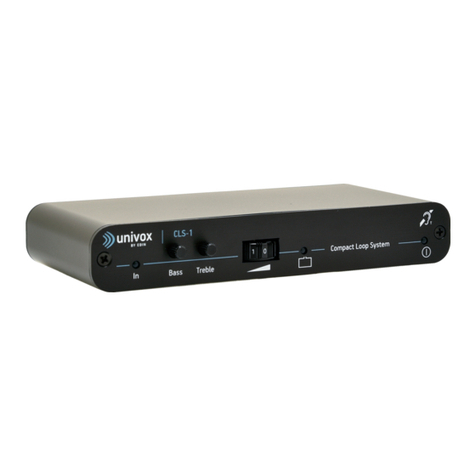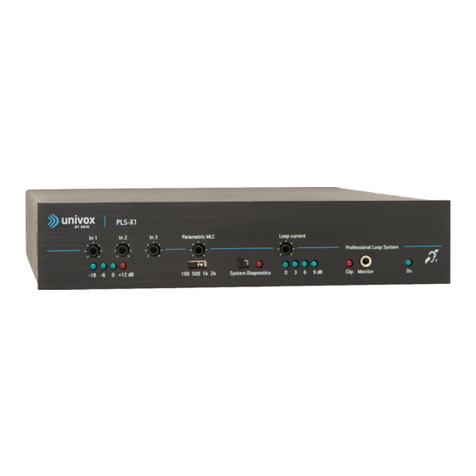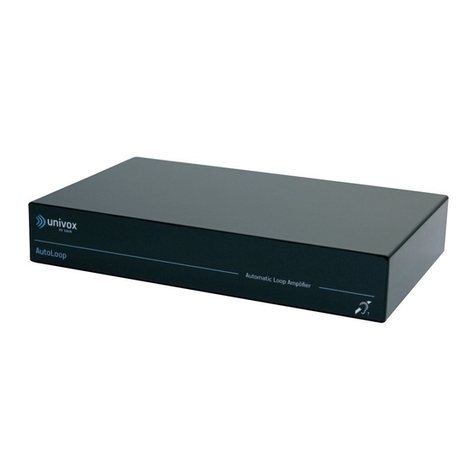
PLS-700 Installation Guide
® PLS-700 Installation Guide
®
General planning and installation procedures.
a) If the loop cable is already planned, install according to the drawings. Then read clause 2.
b) if the loop cable is already planned and installed, read clause 2.
c) If the loop cable is to be planned and installed ”in situ”, please read the following hints.
Hints for planning the loop cable
Hints for planning the loop cable
● Use a 2x2.5mm² twin loop wire, this gives a high fl exibility for the installer. If other loop wires are used, the amplifi er’s
effi ciency may be affected. Recommended minimum loop wire area is described in the table on page 3.
● If the space for the loop cable is limited, a fl at copper foil can be used as an alternative.
● The fi eld strength can be reduced due to reinforcement ironing and such like. If so, the fi eld strength can be doubled
(appr. 6dB) if 2 amplifi ers are used, one for each separate wire of the twin wire, or use a more powerful amplifi er as an
alternative. Do not place input cables close to / in parallel with the loop wire.
● Do not place the loop wire close to reinforcement iron and such like.
● If the smallest distance in a loop exceeds 10 meters, please consider another loop confi guration, like the “eight”-loop.
● Please be aware of the overspill effect. If the overspill is not acceptable, plan the system for UniVox Super Loop System
with minimized overspill. Log on to www.edin.se for more information.
● Beware of the background noises created by other electrical equipment when planning the loop system.
The amplifi er must have free access to
normal room temperature. If the amplifi er
is to be mounted on a wall, the 6 rubber
feet attached shall be mounted. The
amplifi er can be mounted horizontally.
Connect the loop cable to terminal
on the rear panel. Please look at page 4 for 1- or 2-turn loop connections.
on the rear panel. See page 4 for balanced/unbalanced connections. The inputs ”IN1-3” can
be set to different sensitivities according to table. If you need to set IN1-3 otherwise than default, remove the cover and set the
switches S1-20 according to table at page 4.
Disconnect the mains power before removing the cover.
= Microphone level, at input signal IN1 overrides IN3.
= Microphone level, at input signal IN1 overrides IN3.
= Line level, no priority function.
= Line level, no priority function.
= Line level, IN3 is overrided if input signal is present at IN1.
= Line level, IN3 is overrided if input signal is present at IN1.
The AGC-function for inputs IN1-3 can be disabled by setting the switch S18 according to table on page 4.
UniVox PLS-700 has 2 line outputs;
= ”LINE OUT” 0dBm without the input AGC activated (linear), and
on the front panel starts lighting. UniVox PLS-700 has an automatic resettable built-in mains fuse. If
it’s triggered by any reason, please remove the mains power and let the amplifi er cool off. Investigate the possible fault reason
before reconnecting the mains power.
3. FUNCTION CHECK (basic start up check)
one by one letting the LED
on the front panel emitting at the peaks of the program signal source (AGC knee).
on the front panel lits up. Use the loop monitor output
the output current (magnetic fi eld). If necessary, adjust TREBLE with the potentiometer
Recommended minimum loop area for UniVox
when installed to an existing loop system
4. CERTIFICATION – IMPORTANT!
following ”The UniVox Way” for certifi cation according to IEC-60118-4:2006 using a fi eld strength meter, like the UniVox FSM.
UniVox FSM follows the standard of Sound Meter with correct integration time and true RMS measurement.
5. INFORM PEOPLE RESPONSIBLE FOR THE LOOP SYSTEM
how to use the system. Recommend a listening device for a daily basic check of the loop system. UniVox Listener is a high
quality listening device with built-in level check.
Sensitivity Impedance Priority
IN1 / Mic 0.5mV-100mV 7.8 kOhm IN1>IN3 Default setting
IN2 / Mic 0.5mV-100mV -”-
IN2 / Line 25mV-4V -”- Default setting
IN3 / Mic 0.5mV-100mV -”-
IN3 / Line 25mV-4V -”- IN3<IN1 Default setting
IN1 / Mic 0.5mV-100mV 7.8 kOhm IN1>IN3 Default setting
IN2 / Mic 0.5mV-100mV -”-
Sensitivity Impedance Priority
IN2 / Line 25mV-4V -”- Default setting
IN3 / Mic 0.5mV-100mV -”-
IN3 / Line 25mV-4V -”- IN3<IN1 Default setting
Sensitivity Impedance Priority
IN1 / Mic 0.5mV-100mV 7.8 kOhm IN1>IN3 Default setting
IN2 / Mic 0.5mV-100mV -”-
IN2 / Line 25mV-4V -”- Default setting
IN3 / Mic 0.5mV-100mV -”-
IN3 / Line 25mV-4V -”- IN3<IN1 Default setting
Sensitivity Impedance Priority
IN1 / Mic 0.5mV-100mV 7.8 kOhm IN1>IN3 Default setting
IN2 / Line 25mV-4V -”- Default setting
IN3 / Line 25mV-4V -”- IN3<IN1 Default setting
IN1 / Mic 0.5mV-100mV 7.8 kOhm IN1>IN3 Default setting
IN2 / Line 25mV-4V -”- Default setting
IN3 / Line 25mV-4V -”- IN3<IN1 Default setting
Loop area m² Wire area Wire area
300-650 >=5mm² Not recommended
70-150 Not recommended 2x2.5mm²
20-70 Not recommended 2x2.5mm²
Loop area m² Wire area Wire area
300-650 >=5mm² Not recommended
70-150 Not recommended 2x2.5mm²
20-70 Not recommended 2x2.5mm²
Loop area m² Wire area Wire area
300-650 >=5mm² Not recommended
70-150 Not recommended 2x2.5mm²
20-70 Not recommended 2x2.5mm²
